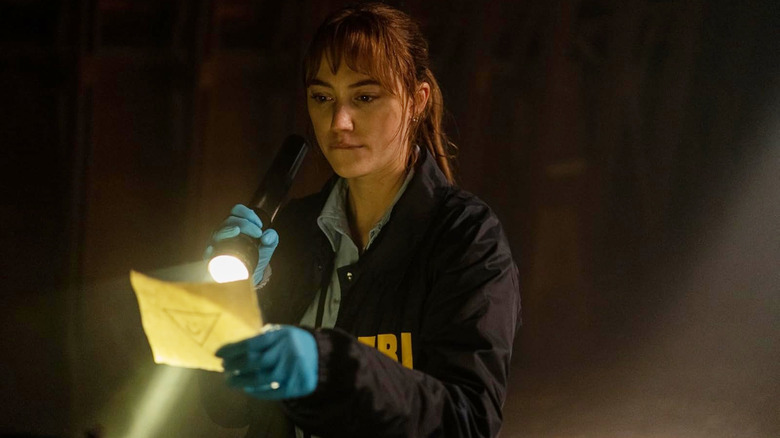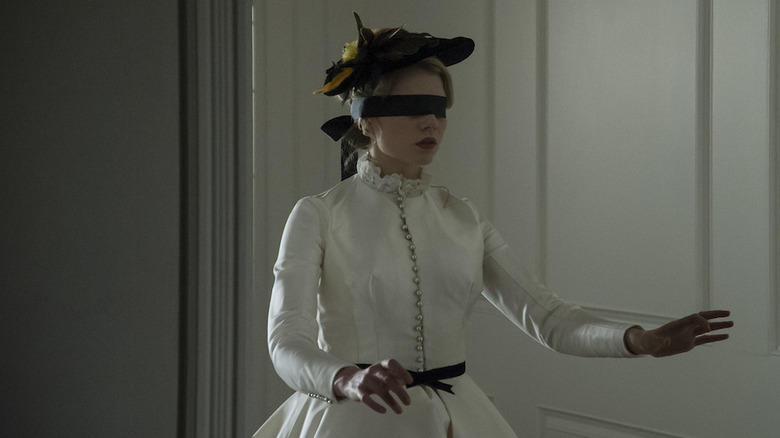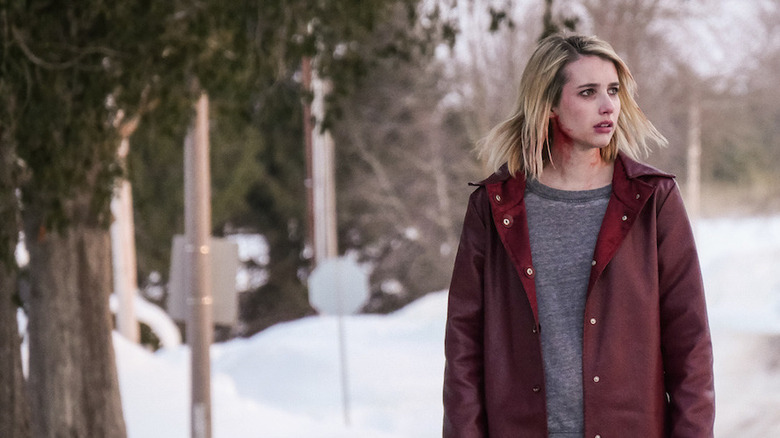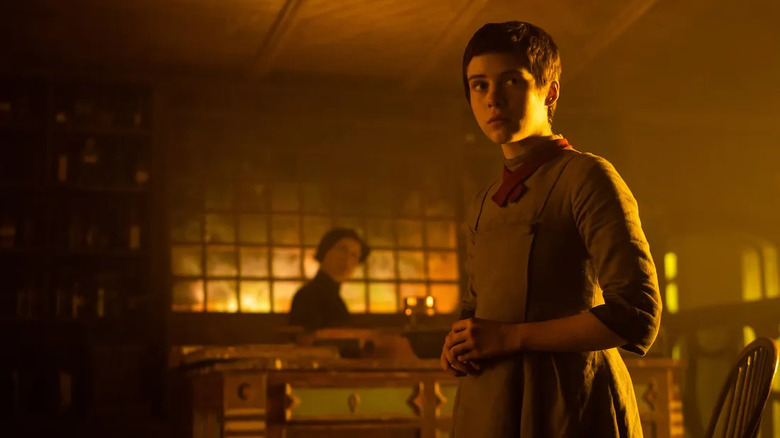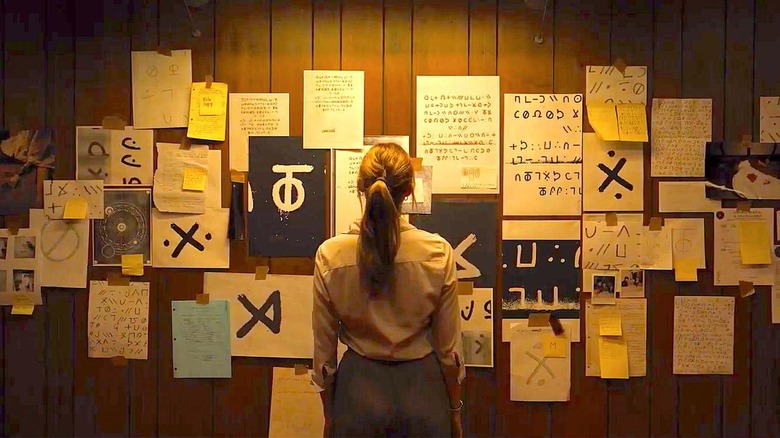The Horror Films Of Director Oz Perkins, Ranked (Including Longlegs)
Oz Perkins, also credited as Osgood Perkins, is a contemporary horror filmmaker with a very distinctive style. His films take ... their ... time. They gradually sink their teeth into you, building suspense slowly until the very last moments of the film, leaving a stinging bite that is hard to forget. Using ambient soundscapes and an often plodding pace, Perkins infuses his films with an existential dread. He artfully plays with light and shadow, crafting very well-composed shots that more often resemble a painting. Perkins uses the camera as his paintbrush, employing techniques like wide angles, low angles, and tracking shots to create a very dynamic palette. Gruesome violence is often presented in a mundane, almost everyday manner. His filmography requires the utmost patience, but it creeps and crawls in the subtlest of ways.
In an interview with MovieMaker magazine, Oz Perkins stated, "Horror movies are self-help movies about dealing with death." This feels especially appropriate since his mother, Berry Berenson, tragically passed in one of the planes on September 11th. His father Anthony Perkins, star of Alfred Hitchcock's "Psycho," passed away when Oz was 18. Most of his films not only have female-centric stories, but also contemplate themes of children being left behind by their parents' death and the questions of legacy — the imprint we leave behind and how relationships can intertwine across generations. With the latest release of his terrifying new film "Longlegs," now is the perfect time to rank all his work.
4. I Am the Pretty Thing That Lives in the House
"I Am the Pretty Thing That Lives in This House" is quite a mouthful, as florid as the ghost-story-within-a-ghost-story narration throughout the film. As a meditation on death from the perspective of three women, "Pretty Thing" is transfixing but not without its flaws. The story centers on a young nurse caring for an elderly horror novelist who lives in a picturesque and potentially haunted 19th century Massachusetts home. It explores how the memories, hopes, dreams, and fears of the dead are embedded within the walls of our home. Oz Perkins also examines how easy it is to become isolated, what the characters call "rotting." By shutting yourself away from the world and basking in your loneliness, you become a living ghost.
As with many of Oz Perkins' films, "Pretty Thing" is almost painfully slow. The camera hovers on various nooks and crannies throughout the house, creating the sensation of being watched by the people that once roamed the halls. The narrative about Polly, the protagonist of Iris' horror novel and the ghost that haunts her, raises intriguing questions about the male gaze and being valued solely for beauty. However, Perkins doesn't dig into these themes deeply enough. The combination of poetic and haunting images with very old-fashioned, novelistic narration makes this one of the truly unique horror films, but perhaps a bit too out there for a lot of viewers. It's all atmosphere and little else.
3. The Blackcoat's Daughter
In his debut feature, Oz Perkins' "The Blackcoat's Daughter" establishes what will become many of his recognizable visual techniques, particularly slow, elegant wide shots. We hover over the isolated spaces of a boarding school during winter break: dark and empty hallways, peering windows, and the vast, icy sky above it. The way his camera idles conjures a foreboding feeling that is difficult to shake, making the audience wait for something evil that may or may not ever come. The terror lies more in the anticipation more so than the actual reveal. Kiernan Shipka, Emma Roberts, and Lucy Boynton all give solid performances as the young women undergoing traumas, especially the loss of Kat's (Shipka) parents. But for all its genuinely frightening moments, "The Blackcoat's Daughter" focuses too much on the aesthetics and the slow burn begins to lose steam once it finally reaches the end. Although, the otherworldly acts we briefly witness in the mechanical setting of the boiler room — captured through stark, voyeuristic shots — make it hard to believe what you're seeing and gives you goosebumps.
2. Gretel & Hansel
Oz Perkins' enigmatic visuals seem tailor-made for the genre of dark folklore in his creative twist on the classic Hansel & Gretel fairytale. Many of Perkins' films evoke traditional fairy tales in their juxtaposition of innocence and death, dreamlike aesthetic, and gruesome underbelly. He changes the title to put Gretel first. Here, she's no longer a little girl but a 16-year-old young woman who must take care of her eight-year-old brother after they've been kicked out of their home. Sophia Lillis gives a shrewd performance as the resourceful teenager forced to seek food, shelter, and work. She also has untapped witchy powers.
Perkins uses his trademark wide shots to lend his environments a foreboding grandeur — especially the expansive, fog-filled woods. The inside of the witch's house, bathed in muted sunset colors from a stained glass window or the soft yellow glow of candlelight, feels as if Gretel and Hansel have just walked into hell itself. It is not a gingerbread house, but the witch does provide plenty of scrumptious food. Like most of Perkins' films, everything serves as a mood piece until the gripping climax that takes place in a massive version of the witch's oven. The Gothic imagery of "Gretel & Hansel" will inevitably draw comparisons to Robert Eggers' "The Witch," but Perkins' is the lesser film for its overreliance on mood more than character. Yet, the shift in focus and inner conflict he gives Gretel and her unsettling fate at the end make this twisted fantasy worth watching.
1. Longlegs
"Longlegs" is Oz Perkins at his most ambitious, expanding from his typically small stories to the wider world of the FBI investigating a serial killer. Maika Monroe is intense as Lee Harker, a stony-faced and determined FBI agent who is socially awkward and has a touch of psychic abilities — making her a special and worthy foil for Longlegs. As Longlegs, Cage delivers one of his wildest yet chilling performances yet. His appearance is uncanny with an upturned nose, high-pitched voice, and pale, bloated face that looks like silly putty. Much like Buffalo Bill in "The Silence of the Lambs," it's the type of eccentric villain that will long be remembered. Much of the film evokes Jonathan Demme's classic, especially in the cat-and-mouse dynamic of a serial killer and his pursuer.
But Perkins' visuals are entirely his own, bringing vivid and gory nightmares to life. The flashbacks in 4:3 aspect ratio evoke the quaint charm of old photographs, but the memories are corrupted by a sinister evil that preys on devout families. "Longlegs" stands out in Perkins' filmography for its blend of procedural drama and trademark unease, though it does not always succeed. The excitement of the investigation is occasionally weakened by his tendency to dwell in the eerie atmosphere. Parts of the film's ending feels hurried and would have benefited from a more taut presentation. Still, "Longlegs" goes to terrifying places that few horror directors venture or are able to portray with such craftsmanship. "Longlegs" illustrates how Perkins continues to grow as a filmmaker with each new release, and we look forward to seeing what he does next.
